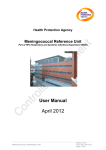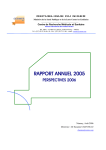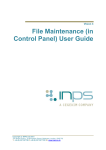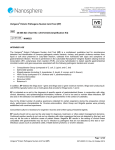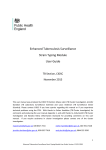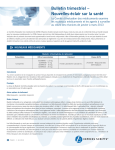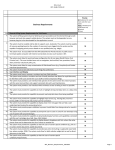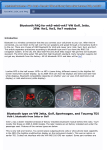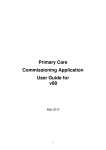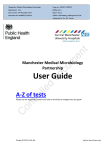Download COVER User Guide
Transcript
National enhanced surveillance of vaccination programmes targeting invasive meningococcal disease in England Public Health England Immunisation Department and Meningococcal Reference Unit Meningococcal disease enhanced surveillance plan About Public Health England Public Health England exists to protect and improve the nation's health and wellbeing, and reduce health inequalities. It does this through advocacy, partnerships, world-class science, knowledge and intelligence, and the delivery of specialist public health services. PHE is an operationally autonomous executive agency of the Department of Health. Public Health England Wellington House 133-155 Waterloo Road London SE1 8UG Tel: 020 7654 8000 gov.uk/phe Twitter: @PHE_uk Facebook: facebook.com/PublicHealthEngland © Crown copyright 2014 You may re-use this information (excluding logos) free of charge in any format or medium, under the terms of the Open Government Licence v2.0. To view this licence, visit OGL or email [email protected]. Where we have identified any third party copyright information you will need to obtain permission from the copyright holders concerned. Any enquiries regarding this publication should be sent to [email protected] . PHE publications gateway number: 2015294 Version number 1.0 1.1 Date 28/08/2015 01/09/2015 Page 2 of 31 Meningococcal disease enhanced surveillance plan Contents About Public Health England ............................................................................................... 2 Executive Summary .............................................................................................................. 4 1. Background .................................................................................................................... 5 2. Objectives....................................................................................................................... 6 3. Definition of a confirmed case of IMD ......................................................................... 6 3.1 Men A/C/W/Y IMD ......................................................................................................... 6 3.2 MenB IMD ..................................................................................................................... 7 3.2.1 A confirmed case of MATS positive MenB IMD case is defined as: ....................... 7 3.2.2 A non-MenB MATS positive confirmed case of IMD is defined as: ........................ 7 4. Enhanced Surveillance for meningococcal disease .................................................. 8 4.1 Existing national surveillance activities ..................................................................... 8 4.2 Routine laboratory investigation of IMD at MRU ...................................................... 8 4.3 Neisseria meningitidis isolate characterisation ......................................................... 8 4.3.1 Phenotypic characterisation.................................................................................... 8 4.3.2 Genotypic characterisation ..................................................................................... 8 4.4 Antibiotic susceptibility testing .................................................................................. 9 4.5 Acute and Convalescent serum samples ................................................................. 9 4.6 Optimum clinical specimens for suspected meningococcal disease ............................. 9 5. National surveillance database ..................................................................................... 10 6. Follow up procedures ................................................................................................. 11 6.1 SUSPECTED IMD CASES reported to HPTs .......................................................... 13 6.2 CONFIRMED CASES reported to PHE Colindale ................................................... 13 7. Possible future considerations for further investigations ....................................... 14 8. Measurement of vaccine coverage ............................................................................ 14 9. Calculation of vaccine effectiveness ......................................................................... 14 10. Dissemination of information and outputs ............................................................... 15 11. References ................................................................................................................... 16 Appendix 1: Surveillance questionnaire (Form MENSV01, August 2015) ..................... 17 Appendix 2: PHE Letters .................................................................................................... 20 Appendix 3: Sample submission form .............................................................................. 24 Appendix 4: Clinical questionnaire (Form MENSV02, August 2015).............................. 26 Page 3 of 31 Meningococcal disease enhanced surveillance plan Executive Summary This document updates and replaces the Joint protocol from the Public Health Laboratory Service (now Public Health England, PHE) and the Institute of Child Health for Surveillance of the impact of the meningococcal group C (MCC) conjugate vaccination programme and protocol for investigation of vaccine failures in England and Wales, published in November 1999. The national surveillance protocol for invasive meningococcal disease (IMD) in England has been extended in recognition of: Changes to the MCC programme, including the removal of the infant MCC dose at 4 months and the introduction of an adolescent MCC dose in June 2013. https://www.gov.uk/government/collections/meningococcal-c-menc-vaccination-programme The emergency introduction of a quadrivalent conjugate vaccine against meningococcal groups A, C, W, and Y (MenACWY) for 14-18 year-olds in August 2015 in response to a national outbreak of a hypervirulent MenW strain belonging to ST-11 clonal complex (Ladhani et al., 2015; Campbell et al., 2015) https://www.gov.uk/government/collections/meningococcal-acwy-menacwy-vaccinationprogramme The introduction of a MenB vaccine, Bexsero®, into the national infant immunisation schedule in September 2015 at 2, 4, 12 months of age (2+1), with a small catch-up for 3 month olds (3-4-12 months) and 4 month olds (4-12 months) https://www.gov.uk/government/collections/meningococcal-b-menb-vaccination-programme This protocol covers the enhanced surveillance plan for invasive meningococcal disease in England with the aim of collecting data for the JCVI to inform national vaccination policy. Page 4 of 31 Meningococcal disease enhanced surveillance plan 1. Background 1.1 Meningococcal C conjugate (MCC) vaccines were introduced into the routine infant schedule in England from November 1st 1999 (Campbell 2010). A phased catch-up programme for all other children up to 18 years began concurrently and was later extended to all students aged up to 25 years. In clinical trials MCC vaccines were found to be safe, immunogenic and to prime for memory and licensure was based on immunogenicity rather than efficacy data. At that time the fundamental requirement for enhanced case confirmation, strain characterisation and surveillance was recognised in order to monitor the impact of these MCC immunisation programmes. An appropriate surveillance strategy was, therefore published in November 1999 and has been in place ever since. Information generated from this surveillance has been key in furthering understanding of the impact of MCC vaccines and has influenced the way that meningococcal conjugate vaccines vaccine programmes were subsequently introduced in other countries, including the MenA vaccination programme in African countries across the meningitis belt. It has also led to changes in the MCC programme in England with a reduction from a 3-dose to 2-dose infant programme based on comparable immunogenicity and the introduction of a Hib-MCC booster at 12 months of age to address waning immunity (Campbell et al., 2010). 1.2. The MCC immunisation programmes had a very rapid and marked impact on invasive MenC disease in the cohorts targeted by vaccine. An indirect effect on age groups outside the immunised group was also apparent with a large reduction in cases in older ages. There have been around 30 MenC cases confirmed annually in England and Wales since 2006/07. MenB now accounts for the vast majority of invasive meningococcal disease (IMD) (Ladhani et al., 2012). In 2014, there were 400 laboratory-confirmed MenB cases in England, with a quarter of cases occurring in infants (<1 year) and a further quarter in 1-4 year-olds (PHE data available here). 1.3. Two quadrivalent conjugate vaccines (offering protection against capsular groups A, C, W and Y; Nimenrix® and Menveo®) are currently licensed for use in the UK (Tan et al., 2010). MenACWY vaccine is currently recommended for travel to endemic areas and for children and adults with asplenia or splenic dysfunction or complement deficiency who may be at increased risk of invasive meningococcal infection. It is also offered to those at close prolonged contact with individuals with confirmed capsular group A, W or Y disease or probable cases with capsular group A, W or Y from a nasopharyngeal swab to reduce the risk of late disease. 1.4. Efforts to develop an effective MenB vaccine initially focussed on MenB outer membrane vesicles (OMVs), which have exhibited varying efficacy and are usually restricted to specific epidemic strains because the immune-dominant antigen (PorA) is highly variable (Tan et al., 2010). In order to provide broader, cross-protective immune responses, more recent vaccines have incorporated outer membrane vesicles from multiple strains with or without recombinant surface proteins such as factor H binding protein (fHbp), Neisserial Heparin binding Antigen (NHBA) and Neisserial adhesin A (NadA). The first of these vaccines, Bexsero® (GSK Biologicals), was licensed in Europe in January 2013 and introduced into the UK infant immunisation programme on 01 September 2015 (https://www.gov.uk/government/collections/meningococcal-b-menb-vaccination-programme) Page 5 of 31 Meningococcal disease enhanced surveillance plan 1.5.This national surveillance plan describes the surveillance of meningococcal disease to inform and evaluate future vaccine policy. The surveillance plan aims to encompass all meningococcal vaccines in the national immunisation programme and their impact on all meningococcal capsular groups across all ages in England. The surveillance plan will be reviewed after the first year in the light of: the surveillance data generated, the programmes adopted and actual vaccine usage, which at present is uncertain. 2. Objectives a) To continue to monitor the impact and age-specific vaccine-effectiveness of the MCC immunisation programme b) To monitor the impact and age-specific vaccine-effectiveness of the MenB immunisation programme in children c) To monitor the impact and age-specific vaccine-effectiveness of the MenACWY immunisation programme in adolescents and evidence of any indirect impact across the population d) To continue to monitor the phenotypic and genetic characteristics of invasive meningococcal isolates e) To describe the clinical characteristics, risk factors and outcomes of IMD as well as acute and convalescent serology in children aged <5 years with laboratory-confirmed IMD following the introduction of the MenB immunisation programme. The monitoring of vaccine safety is also a key aspect of immunisation programme surveillance and will be undertaken by the Medicines and Healthcare Regulatory Agency (MHRA) in collaboration with PHE. 3. Definition of a confirmed case of IMD (a) A case of IMD is defined as an individual with a culture of N meningitidis or identification of meningococcal DNA from a normally sterile site. For the purposes of surveillance, cases will be further classified as follows: 3.1 Men A/C/W/Y IMD A case of Men A/C/W/Y IMD is defined as in individual meeting the case definition for IMD (4a above) and one or more of the following: Phenotypically Men A/C/W/Y culture positive from samples taken from a normally sterile site or from rash aspirate PCR capsular group (siaD) A/C/W/Y positive from sample taken from a normally sterile site or rash aspirate Meningococcal A/C/W/Y antigen detected by latex in blood, CSF or urine. Note: Positivity by a latex method which does not distinguish between A, C, Y and W will not be considered confirmation of any individual group. Page 6 of 31 Meningococcal disease enhanced surveillance plan 3.2 MenB IMD A confirmed case of MenB IMD is defined as an individual meeting the case definition for IMD (4a above) with isolation of MenB or positive capsular group B specific PCR from a normally sterile site. The licensed MenB vaccine, Bexsero®, does not target the polysaccharide capsule (which determines the capsular group) but is based on recombinant surface proteins including an outer membrane vesicle from a specific New Zealand outbreak strain. Although the vaccine was developed to maximise protection against MenB, it also has the potential to protect against invasive disease caused by other capsular groups. Similarly, the vaccine will not protect against all MenB strains – in England, it is estimated that Bexsero® will protect against 73-88% of currently circulating MenB strains (Vogel et al., 2013; Frosi et al., 2013). Thus, additional definitions are required to capture antigen-specific vaccine effectiveness against MenB cases and against all IMD cases. The impact of Bexsero® (4CMenB) will be monitored using the Meningococcal Antigen Typing System (MATS) assay by the MRU. The definition of an isolate with a positive MATS assay result (“MATS positive”) is a N. meningitidis strain with at least one vaccine antigen (fHbp, NadA, NHBA) above the positive bactericidal threshold (PBT) or a positive result for PorA P1.4 by sequencing of VR2 and/or by serosubtyping. 3.2.1 A confirmed case of MATS positive MenB IMD case is defined as: A confirmed case meeting case definition (4a above) plus MATS positive. OR (b) A confirmed case meeting case definition (4a above) with no sterile isolate, but positive MenB-specific PCR from a sterile site plus isolation of MenB from a throat swab, which is MATS positive. 3.2.2 A non-MenB MATS positive confirmed case of IMD is defined as: An individual meeting the case definition for IMD (4a above) with a meningococcal isolate other than MenB or positive sterile-site PCR for a capsular group other than MenB plus MATS positive. OR (b) A confirmed case meeting case definition (4a above) with no sterile isolate, but positive sterile-site PCR for a capsular group other than MenB plus meningococcal isolate other than MenB from a throat swab which is MATS positive. Page 7 of 31 Meningococcal disease enhanced surveillance plan 4. Enhanced Surveillance for meningococcal disease 4.1 Existing national surveillance activities Surveillance of meningococcal disease in England currently relies on collation of information on cases of laboratory confirmed infection identified by the PHE Meningococcal Reference Unit (MRU) in Manchester. Confirmation of IMD cases by MRU relies on serogrouping isolates from culture proven cases and identification of the responsible capsular group by PCR. Regular electronic downloads are made from MRU to the Immunisation Department, PHE Colindale, reporting all meningococcal infections confirmed by MRU and those known by MRU to have a fatal outcome. Ascertainment of fatal laboratory-confirmed cases is supplemented at PHE Colindale by linkage of laboratory reports with meningococcal deaths reported to the Office of National Statistics (ONS). MenC cases have been routinely followed-up since the introduction of the MCC vaccine in November 1999 in order to ascertain vaccination history and other epidemiological data. 4.2 Routine laboratory investigation of IMD at MRU This section summarises the current routine investigations offered by the PHE MRU for suspected cases of invasive meningococcal disease (IMD). The MRU user manual can be accessed directly for more detailed information on the use of these services (http://www.hpa.org.uk/webc/hpawebfile/hpaweb_c/1194947367872). The MRU also offers a free national reference service for meningococcal PCR of clinical samples from suspected IMD cases. If IMD is confirmed by a local diagnostic laboratory the original sample, including extracts from local PCRs, should be referred to MRU to allow the capsular group to be identified. In addition to the routine testing, additional typing may be undertaken in certain situations such as outbreaks. 4.3 Neisseria meningitidis isolate characterisation 4.3.1 Phenotypic characterisation Phenotypic confirmation of N.meningitidis isolates is based on morphology and biochemical reactions. Phenotype identification is routinely undertaken by: Serogroup Identification of capsular polysaccharide antigens by serological reactions is available on request but PCR is preferred for acute samples. Serotype Identification of PorB outer membrane protein (OMP) by a dot-blot ELISA using monoclonal antibodies (mabs). Serosubtype Identification of PorA OMP by a dot-blot ELISA using monoclonal antibodies. 4.3.2 Genotypic characterisation Genotype confirmation is routinely based on identification by: Page 8 of 31 Meningococcal disease enhanced surveillance plan Capsular group: Use of PCR based capsular group confirmation enables identification of non-viable organisms. All suitable submitted samples are tested with an internal control in a N. meningitidis specific (capsular transport gene, ctrA) screening PCR test which also incorporates the PCR MenB-specific assay (based on the sialyltransferase gene, siaD B) and the pneumolysin assay. All non-MenB N. meningitidis reactive specimens are then tested by the capsular group-specific PCR assays (based on siaD) to detect and distinguish MenC, MenY and MenW. Testing for MenA can be performed where indicated using the mynA assay. Subtype: Genetic characterisation of subtype (PorA) by DNA sequencing has been routinely undertaken and reported on all clinical isolates since October 2007. From Jan 2012, MRU has introduced porA subtyping for non-culture samples that are ctrA +ve under cycle number 34. Additional characterisation: following the introduction of the infant MenB immunisation programme, an additional 2 ml EDTA sample will be requested from IMD cases of all ages to undertake additional phenotypic and/or genotypic characterisation to assess whether the infection was potentially vaccine-preventable. This EDTA sample is for storing and must be accompanied by the sample submission form at Appendix 3. 4.4 Antibiotic susceptibility testing The Minimum Inhibitory Concentrations (MICs) routinely determined on submitted isolates are: penicillin, cefotaxime, rifampicin, ciprofloxacin and sulphonamide (sulphamethoxazole) using Etest (Biomerieux) gradient diffusion methodology. Other antibiotic susceptibility tests may be performed on request. 4.5 Acute and Convalescent serum samples Acute and convalescent serum samples are being requested from all vaccine-eligible confirmed/probable MenC cases to help decide on future vaccination of these cases and to investigate the mechanism of disease post-vaccination. Following the introduction of the MenB programme, acute and convalescent serum samples will also be requested from all children younger than 5 years with laboratory-confirmed IMD, irrespective of the meningococcal capsular group responsible or the child’s prior meningococcal immunisation status. 4.6 Optimum clinical specimens for suspected meningococcal disease The recommended clinical specimens for the investigation of suspected IMD should be taken as soon as possible after hospital admission and include: Blood culture EDTA blood for PCR (2 ml) to be sent to the MRU CSF culture (if meningitis suspected and LP not contra-indicated) CSF for PCR (if meningitis suspected and LP not contra-indicated) Throat swab for culture (even if antibiotics have been administered). Culture/PCR of other sterile sites if clinically indicated (e.g. joint fluid, etc) Rash aspirate (if this investigation identified as useful locally). Page 9 of 31 Meningococcal disease enhanced surveillance plan 5. National surveillance database The existing system of electronic downloads from MRU to PHE Colindale of all laboratoryconfirmed IMD cases will continue but at shorter intervals of 1-3 times a week. In the near future, this process will be succeeded by a joint PHE Colindale and MRU meningococcal database currently in development. National data on laboratory-confirmed IMD cases will continue to be published quarterly in the Health Protection Report (HPR). A database holding demographic, clinical, serological and immunological information from the follow up Page 10 of 31 Meningococcal disease enhanced surveillance plan 6. Follow up procedures The follow-up procedure will depend on the age of the patient (< 5 years or ≥5 years) 6.1 Surveillance and Actions for suspected and confirmed cases aged ≥5 years Case status Organisation responsible for follow up Surveillance Action Who needs to take action ►Complete epi surveillance form HPT ►Request Throat Swab for local culture 1. Suspected IMD case aged ≥5 years HPT ►Request two EDTA samples (2ml each) get sent to MRU for PCR-testing. With one sample submission form Hospital clinician and microbiologist ►Remind need to send all meningococcal positive samples to MRU 2. HPT ►Ensure epi surveillance form completed and upload to HPZone or return to PHE HPT PHE ►Review HPZone record & request completion of epi surveillance form by HPT if not already done HPT Confirmed as IMD by MRU with capsular group Page 11 of 31 Meningococcal disease enhanced surveillance plan 6.2 Surveillance actions for suspected and confirmed cases aged <5 years Case status Organisation responsible for follow-up Surveillance Action Who needs to take action ►Complete epi surveillance form HPT ►Request Throat Swab for local culture 1. Suspected IMD case aged <5 years HPT ►Request EDTA sample (2ml) gets sent to MRU for PCR testing ►Request ACUTE serum sample (2ml) be taken & stored (ideally within 72 hours of treatment) Hospital clinician and microbiologist ► Remind need to send all meningococcal positive samples to MRU HPT ►Complete surveillance form and upload to HPZone or return to PHE HPT ►Request stored ACUTE serum be sent to MRU 2. Confirmed as IMD by MRU with capsular group ►Request additional EDTA sample (2ml) be sent to MRU for molecular testing with sample submission form PHE ►Request completion of clinical questionnaire Hospital clinician and microbiologist ►Arrange convalescent sample at 36 weeks after diagnosis ►Review HPZone record & request completion of epi surveillance form by HPT if not already done HPT ►Written request for completing clinical questionnaire (if not completed) 3. 2 weeks post MRU confirmation PHE ►Written request for CONVALESCENT (2ml) serum sample (ideally 3- 6 weeks after diagnosis) to be sent to MRU (with additional EDTA sample (2ml) for molecular testing if not already done) Hospital clinician and microbiologist Page 12 of 31 Meningococcal disease enhanced surveillance plan 6.1 SUSPECTED IMD CASES reported to HPTs Local Health Protection Teams (HPTs) informed of a suspected case of IMD will be requested to complete a short epidemiological surveillance questionnaire (Form MENSV01 see Appendix 1) and notify the clinician of the clinical samples that need to be taken. It may be necessary to contact the GP to obtain an accurate vaccination history for the case. The completed MENSV01 surveillance form should be uploaded to the appropriate HPZone record for the case Because of the importance of ensuring maximal confirmation of cases of IMD by capsular group, HPTs, clinicians and microbiologists are reminded of the importance of taking a throat swab on admission. With immediate plating, positive cultures can be obtained in up to 45% of cases of meningococcal disease. Throat swabs are now routinely recommended for investigation of suspected meningococcal disease because they allow detailed characterisation of the meningococcal isolate in cases that not confirmed by culture (e.g. PCR-confirmed). In order to monitor the different national meningococcal immunisation programmes currently in place, it is also critical that all IMD positive samples are sent to the MRU for confirmation and characterisation. 6.2 CONFIRMED CASES reported to PHE Colindale PHE Colindale will liaise with the local HPTs to ensure that they are aware of the meningococcal capsular group responsible and ensure that that the surveillance form is completed and uploaded on HPZone PHE Colindale will also liaise with the hospital to ensure that the appropriate clinical samples have been forward to the MRU. For children younger than 5 years, the clinical team will also be asked (letters at Appendix 2): • to send serum (2 ml within 72 hours of treatment) for acute serology and an additional EDTA (2 ml) sample for further bacterial characterisation where it is important to use the appropriate sample submission form (see Appendix 3) • to complete the clinical questionnaire (Form MENSV02) and return the form to PHE Colindale by fax, post or email (see Appendix 4) • Arrange for the child with confirmed IMD to have an additional blood test at 3-6 weeks after diagnosis for convalescent serology (2 ml serum sample). PHE Colindale may contact the GP if further epidemiological, clinical and/or immunisation information is required. Page 13 of 31 Meningococcal disease enhanced surveillance plan 7. Possible future considerations for further investigations Under HTA license acute EDTA samples or CSF samples sent to MRU will be stored where possible to allow genetic studies on cases of IMD. Ethics committee approval will be sought before any such use of stored samples is made. 8. Measurement of vaccine coverage Routine coverage data for the proportion of children receiving 2 doses of MCC vaccine by 1st, 2nd and 5th birthday is collected and the proportion of children receiving a dose of MCC-Hib vaccine by 2nd and 5th birthday is currently collected on a quarterly basis through the PHE COVER scheme. National data are also published annually for England by the Department of Health. Vaccine coverage data collection for the teenage age group targeted by MCC and MenACWY conjugate vaccine is under review. Routine collection of vaccine coverage data in teenagers is likely to operate in a similar way to detail currently collected by PHE for the HPV vaccine delivered to teenage girls. These data are collected using the ImmForm website managed by PHE which coordinates and manages the collection and reporting of national data. Coverage data collection will be extended to provide rapid measurement of the proportion of children who are appropriately vaccinated with the MenB vaccine by relevant ages. 9. Calculation of vaccine effectiveness Vaccine effectiveness (VE) is generally defined as the % reduction in the attack rate in vaccinated compared with unvaccinated children in the same birth cohorts. VE will be assessed by the screening method. For this method, the VE can be estimated using the formula below, where PCV is the proportion of cases that are vaccinated and PPV is the proportion population vaccinated (coverage): • VE = 1 - (PCV x (1-PPV)) (1-PCV) x PPV) This requires knowledge of the numbers vaccinated and unvaccinated in the population (by birth cohort or age group) at any given time and the numbers of cases by vaccination status arising in the same period (by birth cohort or age group). Information on the proportions vaccinated by age group and birth cohort will be generated through the COVER scheme described above. The vaccination status of confirmed cases by meningococcal capsular group will be ascertained by routine followup. Age specific vaccine effectiveness estimates will be carried out using cases occurring after implementation of the relevant vaccination campaign in that age group. VE Page 14 of 31 Meningococcal disease enhanced surveillance plan estimates will be generated for the various meningococcal vaccines in eligible cohorts targeted for immunisation. Where possible, VE will also be estimated for vaccine-specific antigens. 10. Dissemination of information and outputs Successful implementation of the national surveillance programme will continue to depend on collaboration of health protection units, immunisation co-ordinators, microbiologists and clinicians looking after patients with IMD. Information on the surveillance scheme will be disseminated widely through PHE Web Pages. This information will include names, contact numbers and addresses of lead individuals for different parts of the programme. Regular reporting already undertaken through publication in the HPR will continue. It is recognised that the MenB vaccine programme will require rapid monitoring and early feedback to assess the impact of the programme. Reports to Joint Committee on Vaccination and Immunisation (JCVI) to include disease incidence and coverage and VE when this becomes available. Page 15 of 31 Meningococcal disease enhanced surveillance plan 11. References Campbell H, Andrews N, Borrow R, Trotter C, Miller E. Updated postlicensure surveillance of the meningococcal C conjugate vaccine in England and Wales: effectiveness, validation of serological correlates of protection, and modelling predictions of the duration of herd immunity. Clin Vaccine Immunol. 2010 May;17(5):840-7. Campbell H, Saliba V, Borrow R, Ramsay M, Ladhani SN. Targeted vaccination of teenagers following continued rapid endemic expansion of a single meningococcal group W clone (sequence type 11 clonal complex), United Kingdom 2015. Euro Surveill. 2015 Jul 16;20(28). pii: 21188. Frosi G, Biolchi A, Lo Sapio M, Rigat F, Gilchrist S, Lucidarme J, Findlow J, Borrow R, Pizza M, Giuliani MM, Medini D. Bactericidal antibody against a representative epidemiological meningococcal serogroup B panel confirms that MATS underestimates 4CMenB vaccine strain coverage. Vaccine. 2013 Oct 9;31(43):4968-74. Ladhani SN, Beebeejaun K, Lucidarme J, Campbell H, Gray S, Kaczmarski E, Ramsay ME, Borrow R. Increase in endemic Neisseria meningitidis capsular group W sequence type 11 complex associated with severe invasive disease in England and Wales. Clin Infect Dis. 2015 Feb 15;60(4):578-85. Ladhani SN, Flood JS, Ramsay ME, Campbell H, Gray SJ, Kaczmarski EB, Mallard RH, Guiver M, Newbold LS, Borrow R. Invasive meningococcal disease in England and Wales: implications for the introduction of new vaccines. Vaccine. 2012 May 21;30(24):3710-6. Tan LK, Carlone GM, Borrow R. Advances in the development of vaccines against Neisseria meningitidis. N Engl J Med. 2010 Apr 22;362(16):1511-20. Vogel U, Taha MK, Vazquez JA et al. Predicted strain coverage of a Meningococcal multicomponent vaccine (4CMenB) in Europe: a qualitative and quantitative assessment. Lancet Infect Dis. 2013 May;13(5):416-25. Page 16 of 31 Appendix 1: Surveillance questionnaire (Form MENSV01, August 2015) Meningococcal disease enhanced surveillance plan Page 19 of 31 Appendix 2: PHE Letters a) b) c) Requesting Acute Serum Sample Requesting Convalescent Serum Sample Requesting EDTA sample from ≥5 year-olds if not already submitted to M Meningococcal disease enhanced surveillance plan Immunisation Department 61 Colindale Avenue London NW9 5EQ, UK T 020 8327 7828 or 6058 F +44 (0)20 8 327 7404 E [email protected] www.gov.uk/phe Surveillance of Invasive Meningococcal Disease PHE ref. _____________ Doctor ……………………… ……………………………… ……………………………… ……………………………… Dear Dr. ……………………., Patient Name: ____________________________ HOSPITAL:______________________________ NHS No. _____________ DOB _____/______/_____ Public Health England (PHE) is conducting enhanced national surveillance of invasive meningococcal disease (IMD) to monitor the impact of meningococcal vaccines in the national immunisation schedule. As part of the surveillance, we are requesting acute serum samples from children with laboratory-confirmed IMD. Since more than half the cases are now diagnosed by PCR only, we are also developing non-culture characterisation of meningococci to monitor vaccine effectiveness. We would, therefore, be grateful if you could also send an extra EDTA sample (2 ml) with the acute serum using the enclosed Sample Submission Form. It is critically important that all positive meningococcal samples are sent to the Meningococcal Reference Unit for confirmation, capsular grouping and genetic/molecular characterisation Could you please also arrange for a blood test for convalescent serology (2ml serum), ideally at 3-6 weeks after diagnosis, and send the sample to the Meningococcal Reference Unit (MRU) using the enclosed Sample Submission Form Our contact details are on the top right-hand corner of this letter. Thank you for your time and help. Yours sincerely Dr Shamez Ladhani Professor Ray Borrow Paediatric Infectious Diseases Consultant Deputy Head of MRU Dr Mary Ramsay Head, Immunisation Department Public Health England has approval under PIAG Section 60 of the Health and Social Care Act 2001 (now subsumed into the National Information Governance Board for Health and Social Care with Section 60, now Section 251 of the NHS Act 2006) to process confidential patient information for public health purposes (see http://www.legislation.hmso.gov.uk/si/si2002/20021438.htm). Page 21 of 31 Meningococcal disease enhanced surveillance plan Immunisation Department 61 Colindale Avenue London NW9 5EQ, UK T 020 8327 7828 or 6688 F 020 8327 7404 E [email protected] www.gov.uk/phe Surveillance of Invasive Meningococcal Disease PHE ref. _____________ Doctor ……………………… ……………………………… ……………………………… ……………………………… ……………………………… Dear Dr. ……………………., Patient Name: ____________________________ NHS No. _____________ HOSPITAL:______________________________ DOB _____/______/_____ Public Health England (PHE) is conducting enhanced national surveillance of invasive meningococcal disease (IMD) in England to monitor the impact of meningococcal vaccines in the national immunisation schedule. We would be grateful if you could complete the enclosed CLINICAL QUESTIONNAIRE for the above-named patient and return it to us by fax, email or in the pre-paid envelope provided, along with a copy of the patient’s HOSPITAL and INTENSIVE CARE (if admitted) discharge summaries. Please complete the questionnaire and send us the requested information even if the patient has since been discharged, transferred to another hospital or died following the infection. Could you please also arrange for a blood test for convalescent serology (2ml serum), ideally at 3-6 weeks after diagnosis, and send the sample to the Meningococcal Reference Unit (MRU) using the enclosed Sample Submission Form Our contact details are on the top right-hand corner of this letter. Thank you for your time and help. Yours sincerely Dr Shamez Ladhani Professor Ray Borrow Paediatric Infectious Diseases Consultant Deputy Head, MRU Dr Mary Ramsay Head, Immunisation Department Public Health England has approval under PIAG Section 60 of the Health and Social Care Act 2001 (now subsumed into the National Information Governance Board for Health and Social Care with Section 60, now Section 251 of the NHS Act 2006) to process confidential patient information for public health purposes (see http://www.legislation.hmso.gov.uk/si/si2002/20021438.htm). Page 22 of 31 Meningococcal disease enhanced surveillance plan Immunisation Department 61 Colindale Avenue London NW9 5EQ, UK T 020 8327 7828 or 6058 F 020 8327 7404 E [email protected] www.gov.uk/phe Surveillance of Invasive Meningococcal Disease PHE ref. _____________ Doctor ……………………… ……………………………… ……………………………… ……………………………… ……………………………… Dear Dr. ……………………., Patient Name: ____________________________ NHS No. _____________ HOSPITAL:______________________________ DOB _____/______/_____ Public Health England (PHE) is conducting enhanced national surveillance of invasive meningococcal disease (IMD) in England and Wales to monitor the impact of meningococcal vaccines in the national immunisation schedule. Since more than half the cases are now diagnosed only by PCR, we are also developing non-culture characterisation of meningococci. We would be grateful if you could also send an EDTA sample (2 ml) using the enclosed Sample Submission Form even if an EDTA sample has already been sent to PHE Meningococcal Reference Unit (MRU) for diagnostic testing. Our contact details are on the top right-hand corner of this letter. Thank you for your time and help. Yours sincerely Dr Shamez Ladhani Professor Ray Borrow Paediatric Infectious Diseases Consultant Deputy Head, MRU Dr Mary Ramsay Head, Immunisation Department Public Health England has approval under PIAG Section 60 of the Health and Social Care Act 2001 (now subsumed into the National Information Governance Board for Health and Social Care with Section 60, now Section 251 of the NHS Act 2006) to process confidential patient information for public health purposes (see http://www.legislation.hmso.gov.uk/si/si2002/20021438.htm). Page 23 of 31 Meningococcal disease enhanced surveillance plan Appendix 3: Sample submission form Page 24 of 31 Meningococcal disease enhanced surveillance plan Professor Ray Borrow, PHE Meningococcal Reference Unit, Clinical sciences Building, Manchester Royal Infirmary, Oxford Road, Manchester M13 9WZ. Tel: 0161 276 6793. E‐mail: [email protected] Surveillance of Invasive Meningococcal Disease Patient Name: ____________________________ NHS No. _____________ HOSPITAL:______________________________ DOB _____/______/_____ Name of Paediatrician: __________________________ Blood Sample(s) for Meningococcal Surveillance This form should be completed and sent with any blood sample taken for meningococcal surveillance. Please write the date when the sample was taken and tick the appropriate box. DATE Sample Taken: ____ / ____ / ____ 1. ACUTE SAMPLES (ideally within 72 hours of starting treatment) Serum sample (2 mL) for acute antibody measurement EDTA sample (2 mL) for non-culture meningococcal characterisation 2. CONVALESCENT SAMPLE (ideally 3-6 weeks after diagnosis) Serum sample (2 mL) for convalescent antibody measurement Completed By: __________________________ Tel:_________________ Date: ...../...... /…… Thank you very much for your co-operation. All samples should be sent through your local laboratory where they will be packaged in accordance with current transport and postal regulations, and MUST BE ACCOMPANIED BY THIS FORM Please send Sample(s) with Form to: Professor Ray Borrow, PHE Meningococcal Reference Unit, Manchester Medical Microbiology partnership, Clinical sciences Building, Manchester Royal Infirmary, Oxford Road, Manchester M13 9WZ. Tel: 0161 276 6793. E-mail: [email protected]. (HAYS DX Meningococcal Reference Unit, DX 6962410, Manchester 90M) LAB use only (comments): Page 25 of 31 Meningococcal disease enhanced surveillance plan Appendix 4: Clinical questionnaire (Form MENSV02, August 2015) Page 26 of 31 Meningococcal disease enhanced surveillance plan Immunisation Department 61 Colindale Avenue London NW9 5EQ, UK T 020 8327 7828 or 6688 F 020 8327 7404 Email:[email protected] Enhanced National Surveillance of Meningococcal Disease Clinical Questionnaire Form MENSV02, August 2015 Patient name: Date of Birth: NHS Number: Date of sample: PHE reference: Section B: Demographics B1 Ethnicity White / Black African / Black Caribbean / Indian / Pakistani / Indian / Bangladeshi / Chinese / Mixed/Other (specify): B2 If born prematurely, gestation at birth: ______________ weeks B3 Underlying Risk Factors None Asplenia / Splenic Dysfunction (including sickle cell disease) Known complement deficiency (including complement inhibitor therapy) Immunosuppression (including HIV) Comments: B4 Any other underlying medical condition: Yes No Comments: B5 Travel abroad in the previous 28 days: Yes No NK If yes, where & date of return: B6 Recently entered UK? Yes No NK Section A: Reporter Details A1 A2 Date of completion of questionnaire: Consultant responsible: ____________________________________________________ Page 27 of 31 Meningococcal disease enhanced surveillance plan Section C: Presentation/Clinical features C1 Date of onset of illness: C2 Date of hospital admission: Time at Presentation: _____:_____ am /pm C3 Date of hospital discharge: C4 Symptoms and signs at presentation: (tick all that apply) History Fever (≥38C) Lethargy Irritability Sore throat/ coryza Breathing difficulty Bulging fontanelle Reduced feeding/appetite Apnoea Headache Thirst Floppy muscle tone Neck Stiffness Nausea/vomiting Leg pain Photophobia Diarrhoea General aches Confusion/delirium Abnormal skin colour Cold hands and feet Drowsy Rash Bone joint pain/swelling Seizures/Convulsions Unconscious C5 Examination on admission Fever: temp on admission C . Rash: macular / popular / maculo-papular / petechial / purpuric / fulminant Reduced GCS (state score if reduced): Seizure: Total seizure duration _____ mins focal or generalised Page 28 of 31 Section D: Complete if admitted to PICU (attach discharge summary if available) D1. Date of PICU admission: Meningococcal disease enhanced surveillance plan discharge: D2. Reason for admission: _______________________________________________________ D3. Type of Support Yes No NK a) Ventilation If Yes No. days _______________ b) Inotropes If Yes No of days ______________ c) Haemofiltration If Yes No of days ______________ d) Surgical procedures If Yes, explain: Section E: Lumbar Puncture (cross out this section if not applicable) E1. If LP done, date: Time taken: _____ : _____ am/pm E2. LP performed before or AFTER antibiotics? If after, how many hours after? _____________ E3. If No, state why: cardiovascular instability respiratory instability E4. CSF WBC count _______ per mm3 Neutrophils ____% CSF RBC count _______ per mm CSF glucose 3 unable to other_______ Lymphocytes ____% CSF protein ________mg/dl ________mmol/l Plasma glucose ________mmol/l Section F: Blood Investigations (on admission) F1. Full Blood count: Hb: _____g/dL Platelets ____x109/L WBC count ____x109/L C-reactive protein: _________mg/L F2. Liver Function Test: Bilirubin ______mg/dL Neutrophil count ___x109/L Not done: Alanine Transaminase (ALT) ___IU/L Not done: Section G: Treatment G1. Antibiotics on admission: ____________________________________________________________ Time of FIRST antibiotic dose: _____ : _____ am / pm Total duration of antibiotics: IV __________ (days) then oral : _____________ (days) G2. Steroid given for meningitis diagnosis: Yes No NK If yes, how many hours after the first antibiotic dose? _______________________ Page 29 of 31 Section H: Please complete if any imaging performed Meningococcal disease enhanced surveillance plan Investigation Performed Yes No NK Scan Normal? Yes No NK Date G1 Cranial Ultrasound G2 CT Head G3 MRI Head G4 Major findings (you can please attach copy of report instead): __________________________________________________________________________________ __________________________________________________________________________________ Section I: Outcomes I1 Did the patient survive the infection? Yes No If died, date: Cause of death: ___________________________________ If survived: I2 I3 Date of last follow-up: At follow-up, did the patient have any of the following?: Yes No NK a) Epilepsy b) Other Neurological complications Thank you for taking the time to complete the Questionnaire Please return the completed form to: Immunisation Department, Public Health England, 61 Colindale Avenue, London NW9 5EQ, UK. Any questions? Please call or email us at [email protected] Page 30 of 31































